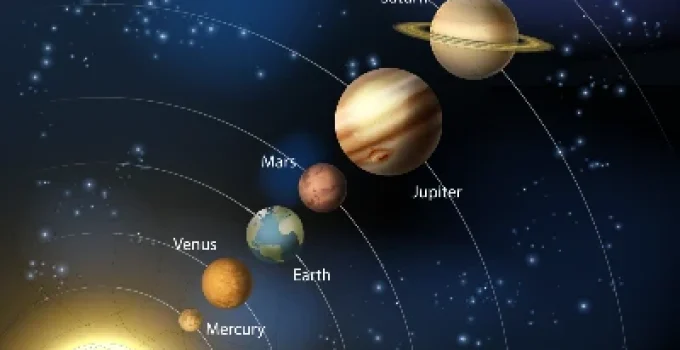Why Do the Planets All Orbit the Sun?
Answer at a Glance: The planets orbit the Sun because of gravity—the powerful force that keeps them from flying off into space. But it’s not just gravity alone. The planets are also moving forward at high speeds. This balance between gravity and motion creates their smooth, curved orbits around the Sun.
🔍 Dive Deeper
- What Is an Orbit?
- How the Sun’s Gravity Controls Everything
- The Role of Motion: Why Planets Don’t Fall In
- Why Are Orbits Mostly Circular?
- 🎯Final Thoughts
- 📚 References
💫What Is an Orbit?
An orbit is the path one object takes as it moves around another object in space. All the planets—including Earth—follow curved paths around the Sun. These paths are shaped by invisible but powerful forces at work.
The idea of orbits was made famous by scientists like Isaac Newton and Johannes Kepler, who studied how planets move and why they don’t crash into the Sun or fly away.
📊 Interesting Stat: Earth travels about 584 million miles (940 million kilometers) each year as it orbits the Sun [1]!
☀️How the Sun’s Gravity Controls Everything
The Sun is extremely massive—it holds 99.8% of all the mass in our solar system. Because of that, its gravity is super strong. Gravity pulls objects together, and in space, that pull reaches very far.
All the planets are caught in the Sun’s gravitational pull. Without it, they would drift off in straight lines through space. Instead, gravity bends their paths into circles or ovals around the Sun.
📊 Interesting Stat: The Sun’s gravity is 28 times stronger than Earth’s gravity [2].
🌌The Role of Motion: Why Planets Don’t Fall In
If gravity pulls the planets toward the Sun, why don’t they just fall into it?
The answer is motion. Each planet is already moving forward through space. Imagine swinging a ball on a string: the string pulls the ball inward, but the ball also moves forward. The result is a steady circular path. That’s what’s happening with planets and the Sun.
This balance between gravity pulling in and forward motion pulling out is what creates a stable orbit.
📊 Interesting Stat: Jupiter moves around the Sun at nearly 29,000 miles per hour (47,000 km/h) [3].
🕳️Why Are Orbits Mostly Circular?
While orbits are often shown as perfect circles, most planetary orbits are actually ellipses, or stretched-out circles. This shape was first explained by Kepler’s laws of planetary motion. Some orbits are more oval than others, depending on the planet’s speed and distance from the Sun.
Still, the orbits are stable and don’t cross over. This keeps the planets from crashing into each other.
| Planet | Shape of Orbit | Distance from Sun (AU) |
|---|---|---|
| Mercury | Elliptical | 0.39 AU |
| Earth | Slightly Oval | 1 AU |
| Mars | More Oval | 1.52 AU |
| Neptune | Nearly Circular | 30.07 AU |
AU = Astronomical Unit (1 AU = distance from Earth to Sun)
📊 Interesting Stat: Pluto’s orbit is so stretched that it sometimes comes closer to the Sun than Neptune [4]!
🎯 Final Thoughts
So, why do the planets all orbit the sun? The reason all the planets orbit the Sun comes down to two key forces: gravity and motion. The Sun’s massive gravity pulls the planets inward, but their forward speed keeps them from crashing. This perfect balance allows the planets to move in smooth, steady paths around the Sun—a system that has worked for over 4.5 billion years.
Understanding orbits helps scientists send satellites, land rovers on Mars, and even predict future paths of asteroids. It’s all part of the amazing physics that keeps our solar system in order.
📚 References
- NASA Solar System Exploration. “Earth’s Orbit.”
https://solarsystem.nasa.gov/planets/earth/overview - NASA. “The Sun.”
https://science.nasa.gov/sun - European Space Agency. “How Fast Do Planets Move?”
https://www.esa.int/kids/en/learn/Our_Solar_System - NASA. “Pluto’s Orbit.”
https://solarsystem.nasa.gov/planets/dwarf-planets/pluto/overview
📌Learn More About Planets
- Why Don’t Planets Collide?
- Which Planet Has the Most Moons?
- Why Do the Planets All Orbit the Sun?
- Which Planet Could Humans Live On?
- Which Planets Have Rings?
